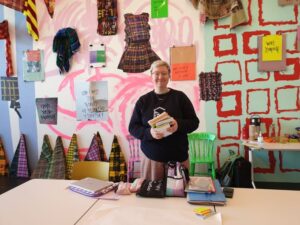Day 12: Make a FanZine
🏴 Creu ffansîn
English
Cymraeg
 Lea is a zine maker and zine librarian at Edinburgh Zine Library. They make zines about all sorts of things, like their experiences of mental health and neurodivergence, their love of cycling, or the best places to get vegan food in Kirkcaldy, where they live with their wife and cat. They encourage other people to explore making zines through in-person and online workshops.
Lea is a zine maker and zine librarian at Edinburgh Zine Library. They make zines about all sorts of things, like their experiences of mental health and neurodivergence, their love of cycling, or the best places to get vegan food in Kirkcaldy, where they live with their wife and cat. They encourage other people to explore making zines through in-person and online workshops.
Some of the first DIY publications that called themselves 'zines' were fanzines made in the 1930s by Science Fiction fans, and people continue to make fanzines today. Zines should be about things you care about, so a great place to start making them is by thinking about things you love.
There's a tendency to think of being creative, of being 'an artist', as some fixed trait that you either have or you don't. Sometimes we might feel like we don't have any Big Ideas, or anything important to say or share with other people, like our experiences don't matter. Sometimes we think we need specific spaces to be creative, like studios or art schools.
But I think it's important to see all the ways that we are all creative, in little and big ways, in our everyday lives. Taking part in a challenge is a great way to flex that creativity, and intentionally make a little time and space for it in our day-to-day life.
I think intentionally doing a small creative activity or action can help connect us to our bigger creative power and make us think about who we are and what we are capable of in different ways!
Do
English
Cymraeg
Today - we are creating a ‘FanZine’, out of a single sheet of A4 paper.
To fold a pocket zine you’re going to need a sheet of A4 paper and a pair of scissors.
Start by folding your piece of paper in half like a book, along the long edge - this is called a hamburger fold.
Fold it again in the same direction.
Open the paper up and it should be divided into four even columns.
Rotate the paper 90 degrees, and fold it in half in the opposite direction, along the short edge - this is called a hotdog fold.
Open up your paper and it should be divided into eight even sections.
Fold the paper in half, the same way we did in the first step (hamburger).
There are three open edges, where the paper isn’t connected, and one folded or closed edge - like the spine of a book.
Using your scissors cut from the centre of the closed edge, into the centre of the page along the folded line.
Don’t go any further than the centre of the page.
Unfold your paper, and you should have a slit in the middle of the page.
Fold the piece of paper in half along the short edge (hotdog).
Take either end in your hands and hold it in front of you, with the folded edge with the slit in it at the top.
As you push your hands together, the slit will become a hole.
Push your hands together further and the hole gets wider.
Push them together more, and the hole collapses into a cross shape.
Flatten all four bits of the cross together, using your fingers or against the table.
Then fold this in half, and this is your pocket zine.
You could also watch the video tutorial here.
Now you have your ‘pocket zine’, fill it with a list of things that you love - your favourite books, films, people, places, foods.
You could do one thing per page, and include an illustration, cut-out picture, or a description of why you love this thing.

Think
English
Cymraeg
Can you come up with a title for your zine?
How would your zine have been different if it had been about things you hate?
Share
English
Cymraeg
You could share your zine with your friends online or via WhatsApp and compare your lists:
What do you have in common?
What do you have that is different?
Your zine folds back out to a sheet of A4 paper, so if you can access a scanner or a photocopier, its easy to make copies of it to share with others.
A pocket zine is called a pocket zine because it fits in your pocket! If you're planning on going out today, take it out with you so you can share it with people you meet.
#TheJanuaryChallenge

free inspiration in your inbox
Join over 26,000+ and sign up for our free newsletter for creative prompts, competitions and inspiring interviews.
You'll receive our weekly newsletter and a daily creative prompt throughout January (you can change your preferences at any time).





